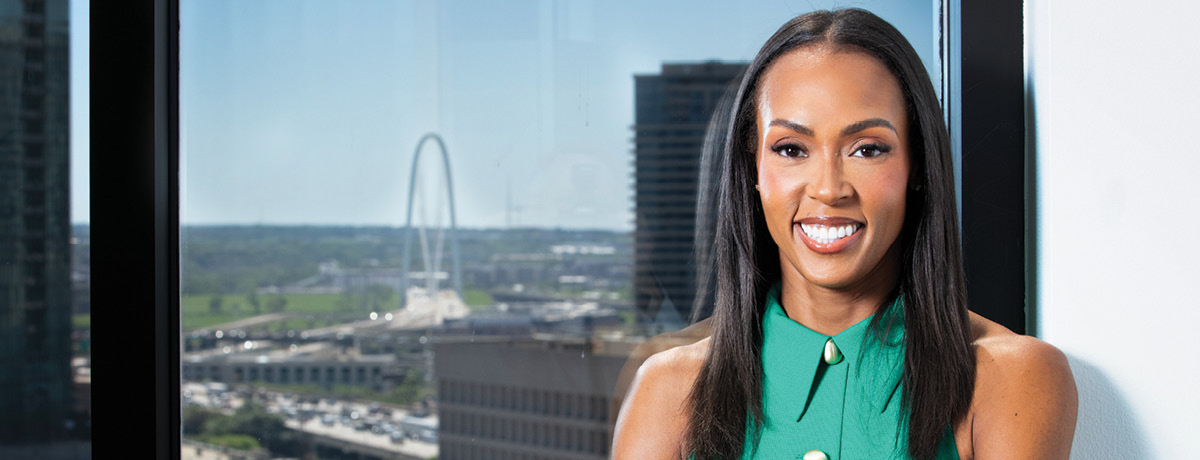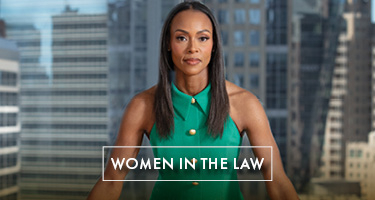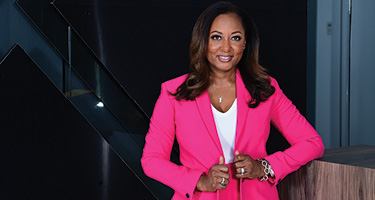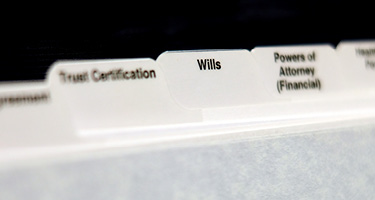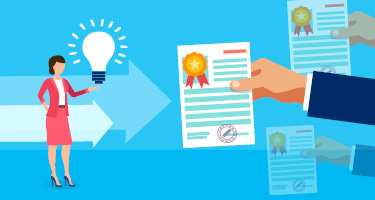Christa Brown-Sanford is a juggler, not a balancer. Trying to get work and life to reach some utopian equilibrium, she says, is a fool’s game. Early in her career, a key mentor employed the metaphor of being able to control, and then catch, many balls in the air: a client service ball here, a childcare ball there. They’ll never hit perfect stasis, he told her, but if you can train yourself to handle them all, you’ll ultimately be fine—inevitable challenges notwithstanding—both personally and professionally.
That telling anecdote underscores what to Brown-Sanford is among the most important aspects of legal success: having, and then being, a supportive mentor. (She even counts a famous sitcom character as inspiration, who showed a young Brown-Sanford that professional success among African American females was no fantasy.) Today, she is one of the top lawyers at Baker Botts, a Houston-based firm with more than 700 attorneys and a dozen offices worldwide. An intellectual-property specialist who leads the firm’s IP team from Dallas, she also lauds the support of her firm, which gave her room to work her way up to partner while starting a family, and her continued commitment to boosting diversity among her fellow lawyers and the clients with whom she works.
As she puts it, she is forever on a mission: to lead a talented group of IP lawyers, to continue important conversations about the makeup of the legal profession and to foster her own development in a constantly changing discipline heavy on science and technology.
What inspired you to pursue a career in intellectual property law, and how has your journey shaped your leadership approach within the firm?
When I was growing up, I watched The Cosby Show. I think most African American kids of my era grew up watching it. I remember one specific episode where I saw the legal prowess of Clair Huxtable [the high-powered attorney and loving, but tough-as-nails, mother played by Phylicia Rashad]. I was like, “That’s what I want to do.” I remember telling my mom at age 12, “I want to be a lawyer.” She said, “You need to do patent law because you’re good at math and science. If you do engineering in college, you can go to law school and do patent law.”
Ever since, my steps have been to get to that point. I went to Rice University, majoring in electrical engineering. As soon as I graduated, I went to law school [at Southern Methodist University], and in 2004, as soon as I graduated, I started at Baker Botts in Dallas focused on patent law. The majority of my life has been to get where I am now at the firm. I worked for so long to get to a certain point, after which I didn’t really have a specific plan—I reacted to situations to get where I am now.
You don’t always have to have a plan. You just find your way.
Absolutely. I didn’t have any lawyers in my family. I was watching Clair for inspiration, and I didn’t appreciate what was involved in being in a big law firm as an associate, let alone as a partner. When I started, I thought, “I’ll use this as a steppingstone.” My dad owned his own business for many years, and I thought I’d go run his company one day.
When I started at Baker Botts, there was one other African American associate in Dallas. No African American associate had been promoted to partner in the Dallas office. During my first year, instead of deciding to work at my dad’s company, I thought, “I may need to stay here. Let’s see if I can make partner.” Over the course of my associate tenure, I had three kids and went on an alternative work schedule. Who’d have thought I’d make partner? I was officially partner as of January 1, 2014. I had become open to possibilities that I didn’t even appreciate or imagine, which was helpful.
What challenges have you faced along the way?
Even now, after 10 years as a partner, I still face challenges, and I’m still learning. How I manage that has taken me a while to figure out. I remember messing something up as an associate. I was like, “I’m done. They’re going to walk me out of this firm.” Looking back, it was not a big deal, but it was a challenge that I had to figure out: “How do I address this?” Now that I’ve progressed, I think those challenges have become more acute. They’re a bit bigger; they have a greater impact. I’m dealing with more balls in the air. But I’ll think, “Christa, what can you learn from this?” I think these challenges are preparing me for something and I ask myself, “What am I being prepared for that I don’t even realize or appreciate?” That has given me a lot of courage and a lot of perspective.
What intellectual-property challenges do companies typically face, and how do you help address them?
If I’m working with an early-stage or small company, their challenge is “How can I afford to pay someone to protect my innovations and make sure other entities don’t steal my ideas?” Larger companies usually have this figured out. They have a lot of in-house counsel, and we’re the outside counsel that usually steps in to tackle the big problems, like litigation that’s hundreds of millions of dollars of exposure or the development of a new product.
I love the clients I work with. You develop deep relationships—they see me as not just their outside counsel but their advisor that is in the trenches with them. How do we maneuver? How are we learning from the things we previously did right to inform us about what we do to get a great result in this situation?
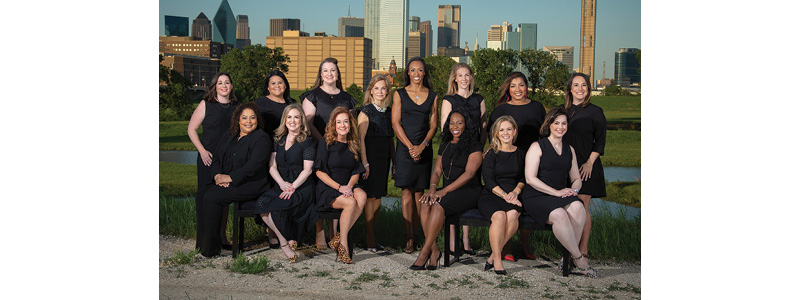
Do intellectual-property disputes ever take you by surprise? Are there cases that leave you wondering how you’ll ever resolve them?
That’s what keeps it interesting. Every day is something new and different. You can be informed by past experiences to help you get to the right place. But nothing is exactly the same, especially in, for example, the technology space. We deal with a lot of emerging technology issues—if it was all exactly the same as before, it would not be new and different technology.
The technical strength of our group allows us to stay ahead of the curve on technology."
One thing that helps me in the area of IP law is truly understanding the clients’ business, taking time to dig in and be invested with them, understanding their IP landscape.
How do you stay updated on the latest developments in intellectual-property law and technology, both in Texas and nationally?
Collaboration. We have one of the largest IP departments at a general practice firm—more than 165 attorneys and professionals. We’re training our partners. We’re training our associates. We’re always in learning mode. That has been our culture for so long—we just embed it in what we do and how we function. Now that I’m the department chair, I want to lean into making sure learning is continuous. A lot of firms probably do this too, but we invest in and are strategic about our training. We meet regularly as an IP partnership to make sure we’re up to speed on how we run our law firm business. Not a lot of lawyers know how to do that.
We also have our associates invested in keeping us abreast on new cases, new strategies, new technology. I think about AI: We have our working group that’s focused on AI, like most firms do, but what is unique about our group is we have a few key people who have really gotten behind the technology of AI and understand that this is what the data set is, this is what artificial intelligence is doing with the data set, that’s how it’s being manipulated, that’s how it’s being trained, and they’re training us internally, in addition to training our clients.
AI is king right now, but what other important emerging trends should businesses be aware of?
AI gets a lot of press, but there are so many other issues companies face. I’ll focus on two. One involves standard essential patents. Telecommunication is one area where this is big. In order for certain things to happen in communication, our devices have to be able to talk to each other. Therefore, there’s going be some commonality in the technology. When people have filed patents to cover the commonality with the technology, they’ll say, “Now that you’re using this technology, you owe me money for using the ideas I have patented.” Those are standard essential patents. Your cellphone is covered by a lot of standard essential patents, and because of the speed with which tech develops, this is regularly an issue: “How do we license that? What is the right royalty rate? If this goes to litigation, will that shut down my production?” That can have a significant impact on the business if it’s not managed properly.
The second is the trade-secret space. I mention it because there has been movement in this area over the last few years and the movement of employees between companies has seen a shift. First, there was the “great quit” a few years ago, and now people are staying as the market softens, and employers have to be ready in all instances. For example, when employees move, they may have access to proprietary company information that they may take to their new employer. If they take that to their next employer, that could have huge trade-secret implications. I was not involved in this case, but our department was involved in a huge trade-secrets case in Dallas last year. It was a $210 million verdict. We represented the trade-secret owner. In that instance, an employee left and was using proprietary information. You’re starting to see more of these cases being filed and companies vigilantly protecting their IP.
Any particularly notable achievements in intellectual property that you’ve been involved in that you can tell us about?
I do licensing deals, and that happens before anything becomes public. So, if I have done my job well, a lawsuit hasn’t been filed and the information won’t be public. But I can tell you about one deal I worked on that is public. We worked with a startup over many years to develop their patent portfolio. It was a small idea that turned into a large multimillion-dollar company. The company focused on how to move products effectively and efficiently to be shipped. They developed robots for a distribution center that go under towers with products on them, and they move the products to the right place to get packed and sent out. We filed and helped this client get almost 40 patents to cover the technology.
The company name was Kiva Systems. They were acquired by Amazon in an over $700 million deal. And while the company had grown tremendously and was doing great things, I have to believe the heart of that deal was the IP—the IP we were involved in developing and strategically thinking through: “What are we going to protect, and how are we going to protect it?” We worked with the inventors hand in hand. That was really cool to be a part of, from the early stages to [becoming] a large company that gets sold to Amazon.
How do you keep yourselves in the know on technology as these big IP legal issues arise?
In our IP department, the folks who do patent law all have technical degrees. Period. That is not the case at other law firms. You will have folks who don’t have an engineering or science background doing litigation. All our people doing patent litigation have engineering or science degrees, and a number of them have advanced degrees—master’s and Ph.D.’s. The technical strength of our group allows us to stay ahead of the curve on technology.
As a female leader of the practice group, has this presented any challenges to you? How have you overcome them?
This question assumes I have overcome them. I am still overcoming every day.
That’s a great thing to say. We always assume we’re on the smooth waters now, but that’s not the way life works.
Having that perspective has helped me when the rough patches begin. Being a woman in this space—engineering is already a male-dominated field. And then having engineers who decide to go to law school and focus on patent law, that’s even smaller. But to be an African American woman doing this? I have dealt with straight discrimination over the course of my career; I have been attacked as a person because of certain roles I’ve had. There are moments when it just hurts. However, I cannot say enough the emotional strength I gain when I recognize that [these difficulties] are preparing me for something else. That’s how I get through these challenges.
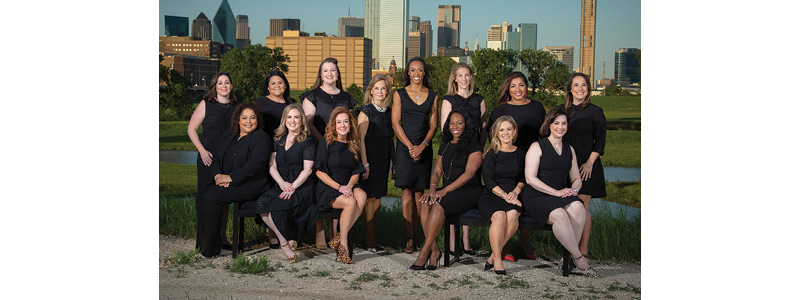
That’s an inspirational outlook.
The women I work with here, the racially diverse attorneys I work with here, they inspire me. They are the reason I still show up every day and fight and give 110% to make this place better—so they don’t have to deal with what I may be going through. It’s not just me, it’s them. It’s me seeing them, too, trying to position things so they have way more opportunity and advantage than I could have even imagined.
You balance a lot: leadership responsibilities, your legal practice, client engagements. How do you stay organized and ensure you’re also able to give your all to your clients?
This is something I’ve been trying to change within our culture, how we engage on this topic of balance. I think we need to get rid of that word, and this is why: What I achieve is not balance. Every day I am juggling. I am reprioritizing every second. “Balance” assumes there’s some equilibrium. When I got to the place in my career where I had more responsibility, I was having children, I was doing things in the community, I thought I had to balance everything, and that created more stress. Work life and home life, they’re not distinct. This is my life. My daughter was here at the office on Monday. My work is part of my home life and my kids’ life on the soccer field. Sometimes I’m on the sideline talking about patent issues because a parent needs guidance on something.
I think we need to get rid of that word, and this is why: What I achieve is not balance. Every day I am juggling. I am reprioritizing every second."
I have shifted to approaching things as if I’m juggling. A mentor of mine, the former department chair for IP here at the firm, once told me, “Christa, I’m going to give you a ball. I just need you to throw up the ball and catch it.” He said, “Once you learn how to do that, I’m going give you another ball, and you’re going learn how to throw up two balls and catch them.” I’m now at the stage where I have 100 balls in the air. It’s reprioritization every day. That’s how I’ve approached my leadership responsibilities, practicing law, the client responsibilities—everything needs to be prioritized, and those priorities have to shift given client needs, firm needs. It’s all about juggle and reprioritization. That has helped me not be so overwhelmed with what is on my plate at any given time.
Aspiring professionals of all kinds wonder how to have a career and a family. What advice would you give a woman who wants it all?
This was something I struggled with after my first [child was] born. I was like, “I’m going to go back. I’m going to do this, and I’m not going skip a beat. I’m going take a shorter leave.” But I had to also give myself grace. A lot of us who enter this profession are incredibly driven, Type A individuals, very goal-oriented, and that’s who I am to the core. However, I also had to adjust my expectations for myself. Women can absolutely have a career, can have family, can do community service. I’m very involved in the Dallas community and have various leadership roles, but you also have to realize that your life is a continuum. Your life is not a finite moment.
I mentioned earlier that I went on an alternative work schedule, and after having two kids as a midlevel, about to become a senior associate, and my husband was working 24 hours a day. He was in finance. He had just gotten a big promotion. I told my mentor, “Something’s got to give.” He worked with me and with leadership at the firm to figure out an alternative work schedule. It wasn’t that I had to leave the profession. I needed to adjust things for a time. And I made partner on that alternative work schedule. Eventually I went back to a nonalternative work schedule as a partner. There have been moments, like when I was president of the Junior League of Dallas, that my husband had to reprioritize certain things to support what I was doing. So, I absolutely think women can have both a career and a family. It’s just [about] changing your perspective, looking at the full picture and not just a snapshot.
You mentioned your own mentor, and presumably you’re now a mentor to young associates. What advice do you give them at the beginning of their career?
This career is a marathon, not a sprint, and you have to have the long-game perspective. Look at mistakes and challenges as opportunities, not negatives. When you’re dealing with a challenge, think about how you can change or grow from the situation and reframe your thinking about it.
Let’s touch on diversity and inclusion in the legal profession, both at Baker Botts and regarding the challenges in the legal space right now.
I was heading the DEI initiative at the firm, and we were dealing with the pandemic and a racial reckoning. A lot of impetus was being put behind DEI. We have absolutely reverted in the broader legal community on those issues. I serve on the board for a university here in Dallas, and just yesterday I was reading an article about how the University of Texas had disbanded its entire diversity and inclusion team. There is no programming anymore, and while that’s in higher education, it’s pervasive within our environment.
We absolutely need to be inclusive of everyone. However, we also need to recognize that we as human beings are different, and as different individuals, we may need different things. There are individuals entering the legal industry that do not have the background or understanding of law firms or being an attorney. And those individuals may need additional support, may need additional sponsorship, may need additional mentoring. It is not hurting the inclusiveness of the profession or the firm by supporting these efforts. We are going to support those who need it, and we are not going to shy away from helping folks thrive and grow. It can be detrimental to our industry if we shift away from that. In order to provide good legal service, I have seen the impact when we have broad perspectives at the table. Period. If we don’t get ahold of this and not be scared, we’re going to revert as an industry. We need to be bold in this conversation.
So how do you at Baker Botts ensure that you’re putting out the image of what you want the legal industry to look like?
I spend extra time trying to know the people I work with, to understand what additional support they may need. You have to invest in people, and that’s one way I try to lead in this effort. I invest in women here; I invest in a number of racially diverse attorneys. Let me give you an example. I’m working on one IP transaction right now. When we got on our call, it was a group of women. Two women from IP, two from corporate, two from finance. I got chills. After, I called my corporate partner and asked, “Did you just see that? Did you see what we just did?”
When I was deputy chair, I created the talent management program. We get data every week about what people are working on, who’s busy, who’s not, who’s bringing in new cases. And I see this group of people who need cases, who need to get their hours up and we’re making new connections, and it’s not just, “Oh, partner, get whoever you want to” without leadership looking broadly across the department. Yes, it [takes] time and effort to review this information and to make sure connections are being made, but it’s important.
Another thing is making sure our pitch teams reflect our values with respect to diversity and inclusion. In IP, we look at the pitch teams before they go out because we want to make sure there is some diversity. Our goal has been to have at least 50% of our pitches be at least 50% diverse, either be it either gender or racial diversity. The last time I checked, 70% of our pitches had over 50% diversity. We started tracking this a few years ago, but now it’s just part of our culture. When you’re consistent, it allows for cultural changes to happen. Regardless of what may be happening in various courts or in legislatures, when you have a cultural shift, that’s when you can make change.
That’s a different way of doing things than in the past. Your work and guidance are changing things from where the firm was even 10 years ago.
In 2019, we had special programming at the firm for Women’s History Month. After participating in the program, I got this little flag that said woman on a mission, and I stuck it outside my office on my nameplate. So, every day when I come in, I see my flag and it propels me through the day. That’s why I’m here. That’s why I show up. I am on a mission.
